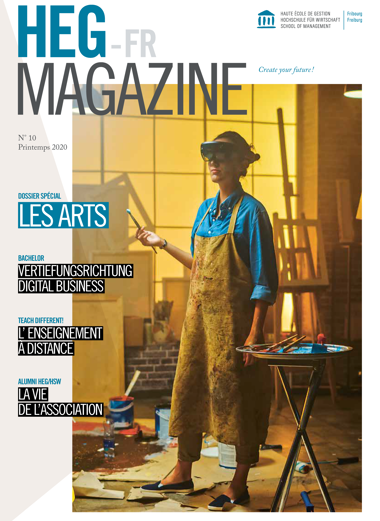10 Jun 2020
The latest edition of the HEG-FR Magazine "Special Edition: Rico Baldegger" is now available in paper or digital version. Moreover, for your information, you can also find all past editions on the HEG-FR website.

Art and entrepreneurial management: surpassing limits
Art, music and management possess interesting parallels and similarities that are not necessarily noticeable at first glance. There is, of course, the art market, with its laws and peculiarities. Points of sale such as Art Basel or the B2B concept shape the market and the milieu of the artists and their clients, generally via galleries or concert organisers.
Edito: Rico Baldegger
Artists, musicians, actors and the like strive to expand their network in order to present and sell their own services in the manner of entrepreneurs. Trial and error is practically in the DNA of artists and this often produces outstanding results. This requires teamwork as well as incorporation into a comprehensive ecosystem. The commercial skills of artists, the way they present their works, their reflections on the target audience, and the networks are crucial factors in their success.
Digitisation has also moved into the arts: musicians are extremely active on social networks, and many artists work creatively with tools such as iPad Arts and successfully build technology into their artworks and exhibitions. Start-ups and culture are merging: at iGroove, for example, artists who sign up can request fast-tracked advances, opening up both innovative production opportunities and product marketing options. What had previously only been possible by means of long-term contracts with labels works equally well on the indie scene. Apart from its funding platform, iGroove is already working on a blockchain solution that is set to revolutionise the distribution of revenue among artists through smart contracts.
Culture and management sciences can be mutually enriching. Interdisciplinarity will become more important in the future, and it would be truly regrettable if individuals did not seek to learn from one another. The various forms of artistic creation can inspire new approaches for managing innovations and influence corporate cultures to be more open and disruptive. The reflections of those who think differently are enriching and contribute, among other things, to the diversity that is often expected to varying degrees. Different ideas and approaches that stimulate the joy of life and a vision of the future, and that weaken the paralysing power of uncertainty, can be a genuine source of inspiration in the current situation. They fuel the belief that we are capable not only of helping to shape the future but also of creating it.
